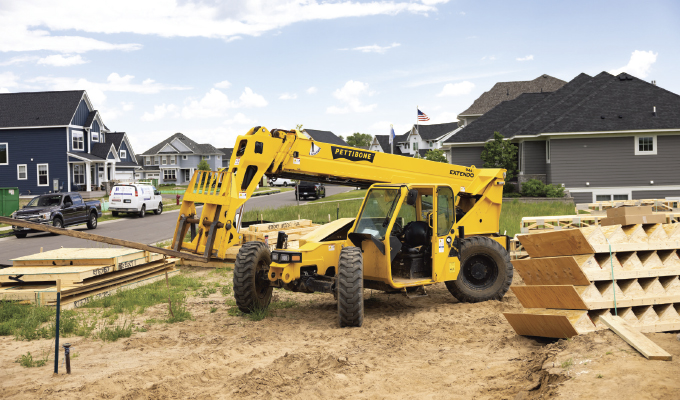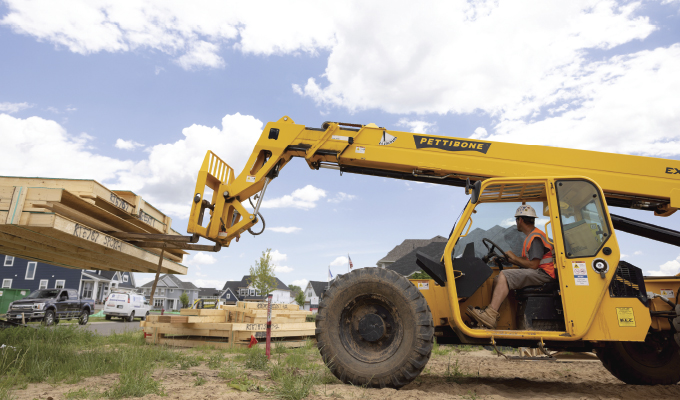When telematics first emerged as a construction industry buzzword, the primary selling point was the ability to track equipment whereabouts and hopefully recover a machine if stolen from a jobsite. While users can still use telematics to make sure their assets are exactly where they are supposed to be, the technology has advanced to provide numerous other benefits for owners of telehandlers and other equipment.
Today, by connecting to the engine control module (ECM), it’s possible to pull up almost any type of engine data. The amount of information generated can be overwhelming, but it’s also fairly simple for different users to focus on only the data points they deem necessary and take advantage of that useful knowledge.
TELEHANDLER TELEMATICS
Telescopic handlers are designed to deliver the lifting power necessary to move heavy loads to elevated heights in a safe and efficient manner. They are often pushed to their limits by operators and must be properly maintained at all times to function properly. With telematics in place, machines have a better chance of performing at a high level for the long haul.
Most telehandler manufacturers offer an optional telematics package. Other manufacturers include a standard multi-year subscription with the purchase of a new machine. The monthly subscription cost is inexpensive considering the information received, especially relative to the potential costs of avoidable equipment repairs. Telematics has quickly become one of the most important factors in protecting the capital investment in a telehandler.
DEALING WITH PROBLEMS
Because telematics provides users with real-time access to the status of a telehandler, many potential issues can be caught and avoided before they can become serious problems. Maintenance alerts cover anything from notifying you that it’s time for a 2,000-hour inspection to checking battery voltage. An error code for the water or fuel indicators might tell you that the fuel-water separator filter needs to be changed. Engine fuel delivery pressure and low coolant level can also trigger alerts.
Certain issues can be troubleshooted remotely using the telematics dashboard on a computer or smartphone app. This is especially advantageous when a telehandler is on a remote jobsite. Instead of service technicians driving out to check on an unknown issue, the problem can be potentially diagnosed and solved with a few taps on a screen.
In other situations, an equipment problem may still require an on-site service call, but the field technicians responding will have more information about the problem. The old-fashioned method of diagnosis often involved a phone call from someone on-site, diving deep into their vocabulary to describe or mimic whatever noise the machine was making, while the mechanic on the other end did their best to guess what the problem could be.
The approach with telematics is far more technical and to the point. The system will provide an error code that explains precisely what is wrong. In fact, depending on the affected components, telematics can even let you know the exact part number that needs replacing. Techs can then ensure they have the necessary replacement part and tools before heading to the jobsite to make the repair, saving time and frustration.
It’s not always possible to have the most skilled and experienced operator in the cab, so having a machine break down due to operator error is another issue that can be minimized. Having telematics to provide alerts to operators is a good proactive measure toward ensuring short-term uptime and the long-term health of your telehandler.

VALUABLE INFO
Uptime can also be increased by instituting a consistent maintenance schedule, and telematics can help. Keeping tabs on utilization and service intervals may be easy for those with minimal equipment inventory, but for those with multiple telehandlers in a bigger fleet, it’s easy to lose track of which machines are logging the most hours and may be approaching service milestones sooner than others.
Telematics removes all the guesswork, providing observable data points such as engine hours, fuel rate and usage, diesel exhaust fluid levels, battery voltage and more. It may also advise you if existing service intervals need to be modified to a greater frequency.
Beyond valuable maintenance information, telematics might also reveal some bad operational habits. Engine speed, torque and load can all be analyzed to see if a machine is being overworked. Fuel usage can come under even more scrutiny than usual when analyzing how many thousands of gallons of fuel are burned while the machine is just idling.
DAILY CHECKS
Telematics is an extremely useful, cost-saving tool, but it is not a substitute for the daily service needs of a heavy-duty material handler. Operators and service technicians should continue to follow OEM recommended service intervals and perform daily pre-operation checks.
Simple daily procedures like checking engine oil, transmission fluid, air filters, and keeping the machine greased help ensure the longevity of the machine and avoid more serious and costly repairs. There are several grease points for a telehandler boom, all of which should be greased per manufacturer specifications to prevent friction that can wear out pads more quickly.
Do visual inspections before starting work. Be alert to leaks, rust, damage, fluid levels, safety guards, and anything that doesn’t look right. Tires should be inflated to the proper PSI and inspected for damage. Failing to do these checks could lead to longer delays and productivity losses.
CLOSING THOUGHT
To maximize your telehandler investment and ensure it’s always safe to use, keep it in good working order with regular maintenance, and consider the use of telematics. Real-time access to machine data saves time and hassle for maintenance technicians and operations.
About the Author:
Mitch Fedie is product manager for Pettibone/Traverse Lift, LLC. Pettibone has been a leading provider of material handling equipment since revolutionizing the industry with the first forward-reaching, rough-terrain machines in the 1940s. For more information, visit www.gopettibone.com.
Modern Contractor Solutions, November 2023
Did you enjoy this article?
Subscribe to the FREE Digital Edition of Modern Contractor Solutions magazine.



